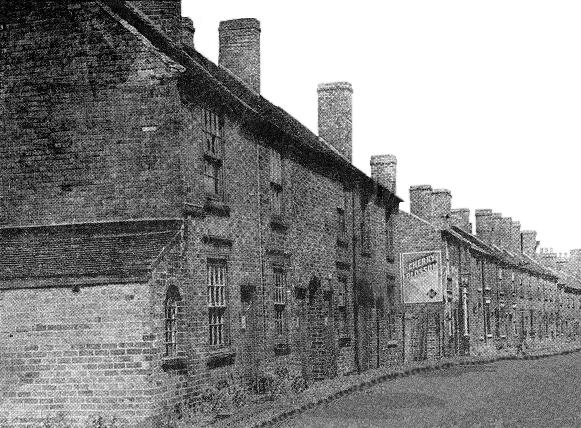|
Western Darlaston
The area had previously been
exploited for its abundant coal deposits; and many spoil
heaps, and hollows left from the filled-in pit shafts
remained. The remnants of Herberts Park Forge could be
found at the western end of Forge Road (now Herberts
Park Road), and parts of the old Wood’s brick works
could still be seen by the canal at Moxley. There were
sand pits, clay pits, and pools; and in the middle of it
all, Andrews Farm and a herd of cows.
The old Victorian terraced houses
were tightly packed along the few decent roads that were
there at the time, mostly on land that had been
untouched by the coal mines. Sometimes houses were built
behind others with a courtyard in-between. They became
known as “the courts”, each with its own small,
close-knit community of not so well-off people, who
greatly enjoyed life, much as we do today.
|

Foundry Street. Some
of the typical Victorian housing in the
area. |
During the 19th century
the local population increased to such an extent that
houses were in short supply and many of them, usually
with just two rooms up and 2 down, housed several
families, often with a whole family living in a single
room. In 1881 the town had a population of 13,600. By
1920 this had increased to over 18,000. The town had a
total of 3,708 houses, most of which were concentrated
on the western side of the town in Catherine’s Cross
Ward. The distribution was as follows:
|
Catherine’s Cross Ward |
1,180 |
| The
Green Ward |
925 |
|
All Saints’ Ward |
871 |
|
Central Ward |
732 |
|
Total
|
3,708 |
Most of the houses had no internal
water supply, washing facilities being provided at the
back in an external brewhouse, with a tap, a sink, and a
boiler. There was usually a back yard, and of course an
outside toilet. Some houses, even in the early 1920s
were not connected to a sewer, and so the toilets were
emptied at night by the night soil men, who had the
unpleasant task of taking the contents of countless
toilets to the local sewage dump on a horse-drawn cart.
There were no toilet rolls, people used old cut-up
pieces of newspaper.
The streets were lit by gas, and
every day the lamplighter would do his rounds at
lighting-up time, lighting the lamps and then
extinguishing them at daylight.
The area reverberated to the sounds
of industry. There were dull thuds from forging
machines, echoing hammering noises as steel objects were
hammered in the factories, clattering noises as steel
bars and strips were moved around, humming noises from
the machines, and a dull red glow in the sky at night.
All typical sights and sounds of the Black Country. |